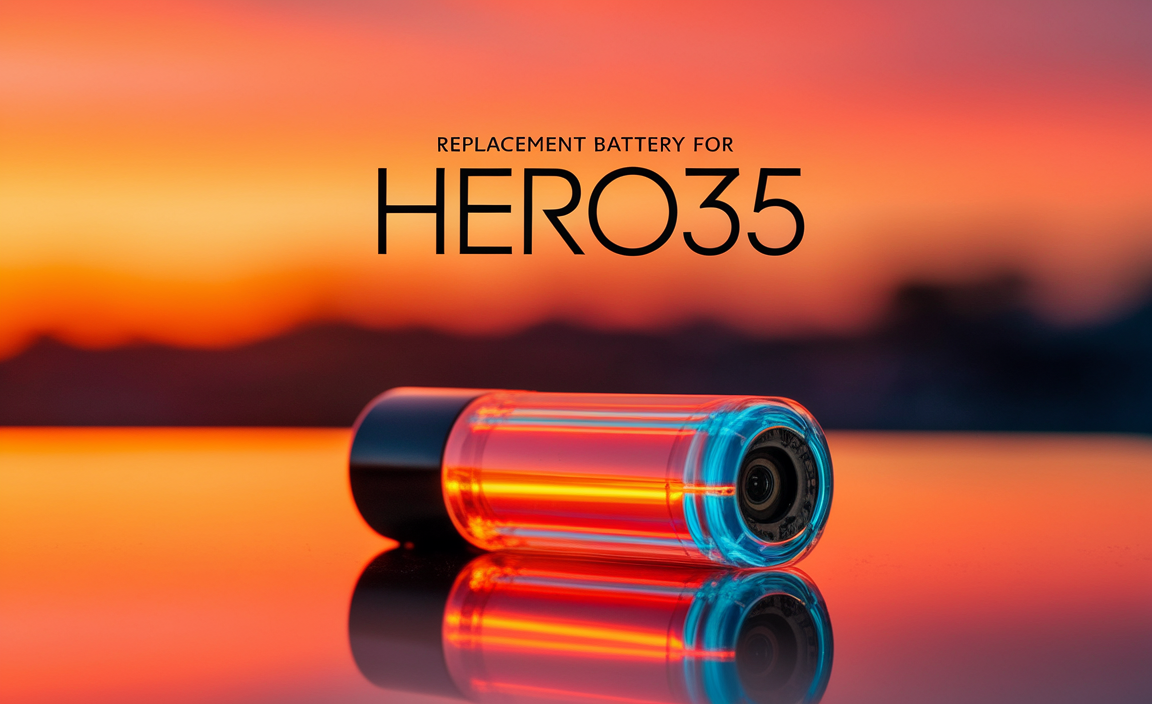The right battery for your 2020 Jeep Grand Cherokee is key for reliable starting and powering its systems. Choosing the correct size (Group Size H6/Group 48 is common), Cold Cranking Amps (CCA), and voltage ensures your Jeep performs optimally. This guide helps you find the perfect fit and understand its care.
Having your 2020 Jeep Grand Cherokee not start on a cold morning is a frustrating experience, especially when you have places to be. The battery is the heart of your vehicle’s electrical system, and over time, it can weaken and eventually need replacing. But picking the right one doesn’t have to be complicated. I’m here to walk you through everything you need to know about the battery for your 2020 Jeep Grand Cherokee, making sure you get the essential power your SUV needs to run smoothly and reliably.
We’ll cover the best battery types, how to find the right fit for your specific Grand Cherokee model, and some simple maintenance tips to help your new battery last longer. Think of me as your go-to guy for all things battery-related, ready to make this task feel easy and straightforward.
Understanding Your 2020 Jeep Grand Cherokee’s Battery Needs
Your 2020 Jeep Grand Cherokee, like any modern vehicle, relies heavily on its battery. It’s not just for starting the engine; it powers your lights, radio, navigation, and all the sophisticated electronics that make driving comfortable and safe. Over time, batteries naturally degrade, especially in extreme temperatures. A weak battery can lead to slow cranking, dimming lights, and eventually, a vehicle that won’t start at all.
The good news is that identifying the correct battery for your 2020 Grand Cherokee is a straightforward process. It involves understanding a few key specifications and knowing where to look. Let’s break down what makes a battery suitable for your specific SUV.
Key Battery Specifications Explained
When you’re looking for a new battery, you’ll see a few numbers and terms on the label. Here’s what they mean in simple terms:
- Group Size: This is like the battery’s physical blueprint – its dimensions and terminal placement. For many 2020 Jeep Grand Cherokee models, the common group size is H6, also known as Group 48. This ensures it fits correctly in the battery tray and connects properly.
- Cold Cranking Amps (CCA): This is a measure of the battery’s power to start your engine in cold weather. Higher CCA means a stronger start, especially crucial in colder climates. Your Jeep owner’s manual or a good auto parts store can tell you the recommended CCA for your specific model. We’ll talk more about this later in the guide.
- Voltage: Most car batteries are 12-volt systems. It’s highly unlikely you’ll need anything else, but it’s worth noting that this is standard.
- Reserve Capacity (RC): This tells you how long the battery can provide power if the alternator stops working. It’s a good indicator of overall battery endurance.
Choosing the correct specifications ensures your Jeep’s electrical system receives stable power, preventing issues and maximizing the battery’s lifespan.
Finding the Right Battery: Group Size H6 / Group 48
As mentioned, the most common battery size for the 2020 Jeep Grand Cherokee is the Group Size H6, which is also labeled as Group 48. This standardization makes finding a replacement much simpler. However, it’s always best to verify this for your specific trim level.
Why is the group size so important? A battery that’s too large won’t fit in the battery tray, and one that’s too small might not have secure mounting, leading to vibrations that can damage the battery. Terminal posts also need to align correctly with your Jeep’s battery cables.
How to Confirm Your Battery’s Group Size:
- Check Your Current Battery: The group size is usually printed on the side of your existing battery.
- Consult Your Owner’s Manual: Your Jeep’s manual is the definitive source for all specifications, including the battery group size.
- Use Online Tools: Many auto parts store websites have a “fitment guide” where you can enter your vehicle’s year, make, and model to see compatible batteries.
Here’s a quick look at what you might find:
| Vehicle | Common Battery Group Size | Notes |
|---|---|---|
| 2020 Jeep Grand Cherokee | H6 / Group 48 | Check owner’s manual or current battery for exact confirmation. |
| 2020 Jeep Grand Cherokee L | H6 / Group 48 | Similar requirements, but always double-check. |
Remember, while H6/48 is common, variations can exist, especially with different engine options or specific packages on your 2020 Grand Cherokee. Always cross-reference.
Beyond Group Size: CCA and Battery Technology
Once you’ve confirmed the group size, let’s talk about performance. Cold Cranking Amps (CCA) are a critical factor, especially if you live in an area with cold winters. The recommended CCA for your 2020 Grand Cherokee will be listed in your owner’s manual. It’s generally a good idea to meet or exceed this recommendation.
You’ll typically see lead-acid batteries, but these days, there are different types to choose from, each with its pros and cons:
- Flooded Lead-Acid Batteries: These are the most traditional and usually the most affordable. They require maintenance, like checking the electrolyte levels, though many are now “maintenance-free” which means sealed.
- Enhanced Flooded Batteries (EFB): These are a step up from traditional flooded batteries. They offer better performance and lifespan, especially for vehicles with basic start-stop technology or higher electrical demands.
- Absorbent Glass Mat (AGM) Batteries: AGM batteries are sealed and spill-proof. They offer excellent performance, vibration resistance, and a longer lifespan. They are also ideal for vehicles with advanced start-stop systems and high power demands, which is increasingly common in modern SUVs like the 2020 Grand Cherokee. When replacing a battery, especially if your original was an AGM, it’s usually best to replace it with another AGM for optimal performance and compatibility with your vehicle’s charging system.
Which Technology is Best for Your 2020 Grand Cherokee?
For a 2020 Jeep Grand Cherokee, especially those equipped with more advanced electronics or start-stop functionality, an AGM battery is often the recommended choice. They are designed to handle deeper discharge cycles and deliver more consistent power. If your original battery was an AGM, it’s highly advised to replace it with another AGM battery to ensure compatibility with your vehicle’s power management system. Replacing an AGM with a standard flooded battery can sometimes lead to premature failure and issues with your vehicle’s electronics.
Always check your owner’s manual or consult a professional if you are unsure about the type of battery your Grand Cherokee came with or what is recommended.
Replacing Your Jeep Grand Cherokee Battery: A Step-by-Step Guide
Replacing your car battery can seem daunting, but it’s a task many DIYers can handle with the right tools and a bit of caution. Safety first! Always wear safety glasses and gloves, as battery acid is corrosive.
What You’ll Need
Gather these tools before you begin:
- Wrench Set: You’ll need a wrench that fits the terminal nuts and the battery hold-down clamp. A 10mm and 13mm wrench are common sizes, but it can vary.
- Battery Terminal Cleaner Brush: To clean corrosion from the terminals and cable ends.
- Safety Glasses and Gloves: Essential for protecting yourself.
- New Battery: The correct Group Size (H6/Group 48) and type (AGM recommended for many) for your 2020 Grand Cherokee.
- Anti-Corrosion Spray or Grease: Optional, but recommended for protecting the terminals.
- Small Rag or Paper Towels: For cleaning up.
The Replacement Process
Here’s how to safely swap out your old battery:
- Park Safely and Turn Off Everything: Make sure your Jeep is in park, the engine is off, and all lights and accessories are turned off.
- Locate the Battery: In most 2020 Jeep Grand Cherokee models, the battery is located under the hood, typically on one side of the engine bay.
- Disconnect the Negative Terminal First: This is the most crucial safety step. The negative terminal is usually marked with a “-” symbol and has a black cable. Loosen the nut on the clamp and carefully remove the cable from the terminal. Tuck it away so it can’t accidentally touch the battery post.
- Disconnect the Positive Terminal: The positive terminal is marked with a “+” symbol and has a red cable. Loosen the nut on this clamp and remove the cable.
- Remove the Battery Hold-Down Clamp: Batteries are secured by a bracket or clamp at the base. There will be a bolt or nut holding it in place. Use your wrench to remove this clamp. Keep the hardware safe.
- Lift Out the Old Battery: Batteries are heavy! Grip it firmly by the handle (if equipped) or the sides, and lift it straight up and out of the tray. Be careful not to strain your back. If it feels too heavy, get some help.
- Clean the Battery Tray and Terminals: Use your rag to wipe down the battery tray. Use the terminal brush to clean any corrosion from the battery cable ends. This ensures a clean connection for the new battery.
- Install the New Battery: Carefully lower the new battery into the tray, ensuring it’s oriented correctly (terminals facing the right way).
- Secure the Hold-Down Clamp: Reinstall the hold-down clamp and tighten its bolt or nut. Make sure the battery is snug and doesn’t move.
- Reconnect the Positive Terminal First: Place the red (positive) cable clamp onto the positive (+) terminal and tighten the nut securely.
- Reconnect the Negative Terminal: Place the black (negative) cable clamp onto the negative (-) terminal and tighten the nut.
- Apply Anti-Corrosion Protection (Optional): You can spray a thin layer of anti-corrosion spray or apply a small amount of dielectric grease to the terminals to prevent future corrosion.
- Start Your Jeep: Start the engine to ensure everything is working correctly. You might notice your radio presets are lost, and you may need to re-sync some power windows.
Important Note on Battery Disposal: Never throw a used car battery in the regular trash. Batteries contain hazardous materials. Most auto parts stores and service centers will accept old batteries for proper recycling. Many places even offer a core charge for your old battery, giving you a small discount on the new one.
Battery Maintenance Tips for Longevity
Once you’ve got your new battery installed, a little bit of care can go a long way in extending its life and ensuring reliable performance for your 2020 Jeep Grand Cherokee.
Regular Checks
- Clean Terminals: Periodically check the battery terminals for any signs of corrosion (a white or greenish powdery substance). Clean them with a wire brush and a solution of baking soda and water if you see any.
- Check Hold-Down: Ensure the battery hold-down is still tight. A loose battery can be damaged by vibrations.
- Inspect for Damage: Look for any cracks or leaks on the battery case. If you see any, it’s time for a replacement.
Environmental Factors
- Temperature Extremes: Batteries work harder in both extreme heat and cold. Parking in a garage can help regulate temperature.
- Short Trips vs. Long Trips: Frequent, short trips don’t give the alternator enough time to fully recharge the battery. If you primarily do short trips, consider taking your Jeep for a longer drive periodically to ensure the battery gets a good charge.
Understanding Battery Drain
Leaving lights on, an interior light staying illuminated, or a faulty electrical component can drain your battery even when the engine is off. Regularly check that all lights and accessories are turned off when you leave your vehicle. If you suspect a parasitic drain (where something is drawing power when it shouldn’t be), it’s best to have a mechanic diagnose it.
Smart Charging
If your Jeep sits for extended periods without being driven, especially in very cold weather, the battery can lose charge. Using a smart battery charger (a charger designed to automatically maintain the battery’s charge without overcharging) can be beneficial. You can find excellent resources on battery care and technology from organizations like the Battery Council International, which provides industry standards and information.
| Maintenance Task | Frequency | Why It’s Important |
|---|---|---|
| Clean Terminals | Every 6-12 months, or as needed when corrosion appears | Ensures good electrical contact and prevents power loss. |
| Check Hold-Down Clamp | Every 6-12 months | Prevents battery damage from vibration. |
| Inspect for Damage | Every 6-12 months | Identifies leaks or cracks that indicate a need for replacement. |
| Longer Drive Periodically | If doing mostly short trips | Ensures full battery recharge by the alternator. |
When to Consider a Professional
While replacing a battery is often a DIY job, there are times when it’s best to trust the experts:
- Uncertainty: If you’re not comfortable with basic car maintenance or aren’t sure about the correct battery type or installation process.
- Complex Systems: Some vehicles have battery management systems that require special diagnostic tools for replacement. While the 2020 Grand Cherokee might not always require this, it’s good to be aware.
- Signs of Electrical Issues: If your Jeep is experiencing other electrical problems (flickering lights, strange warning lights), a battery replacement alone might not fix the root cause.
- Lack of Tools or Space: If you don’t have the necessary tools or a safe place to work on your vehicle.
Mechanics have the specialized knowledge, tools, and diagnostic equipment to ensure the job is done correctly and safely. They can also confirm the exact battery specifications needed for your specific 2020 Grand Cherokee model and help you choose the best brand and type for your needs.
Frequently Asked Questions (FAQ)
Q1: What is the best battery brand for a 2020 Jeep Grand Cherokee?
There are several reputable battery brands known for quality and reliability, such as Optima, Odyssey, Bosch, ACDelco, and DieHard. The “best” brand can depend on your specific needs and budget. For many 2020 Grand Cherokees, an AGM battery from a trusted manufacturer is a great choice due to its durability and performance, especially if your vehicle is equipped with advanced electronics or a start-stop system. Always prioritize getting the correct group size (H6/Group 48) and adequate CCA.
Q2: How long should a battery for a 2020 Jeep Grand Cherokee last?
The lifespan of a car battery can vary widely depending on factors like climate, driving habits, and battery quality. On average, a car battery can last between 3 to 5 years. In extreme climates (very hot or very cold), this lifespan might be shorter. Proper maintenance, like keeping terminals clean and ensuring it’s fully charged, can help extend its life.
Q3: Can I replace my 2020 Grand Cherokee battery myself?
Yes, replacing the battery is usually a straightforward DIY task for most 2020 Jeep Grand Cherokee owners. You’ll need a few basic tools like wrenches, safety gear (gloves and glasses), and the correct replacement battery. The key steps involve safely disconnecting the old battery (negative terminal first), removing it, installing the new one, and reconnecting the terminals (positive terminal first). Always refer to your owner’s manual or reliable guides for specific procedures.



